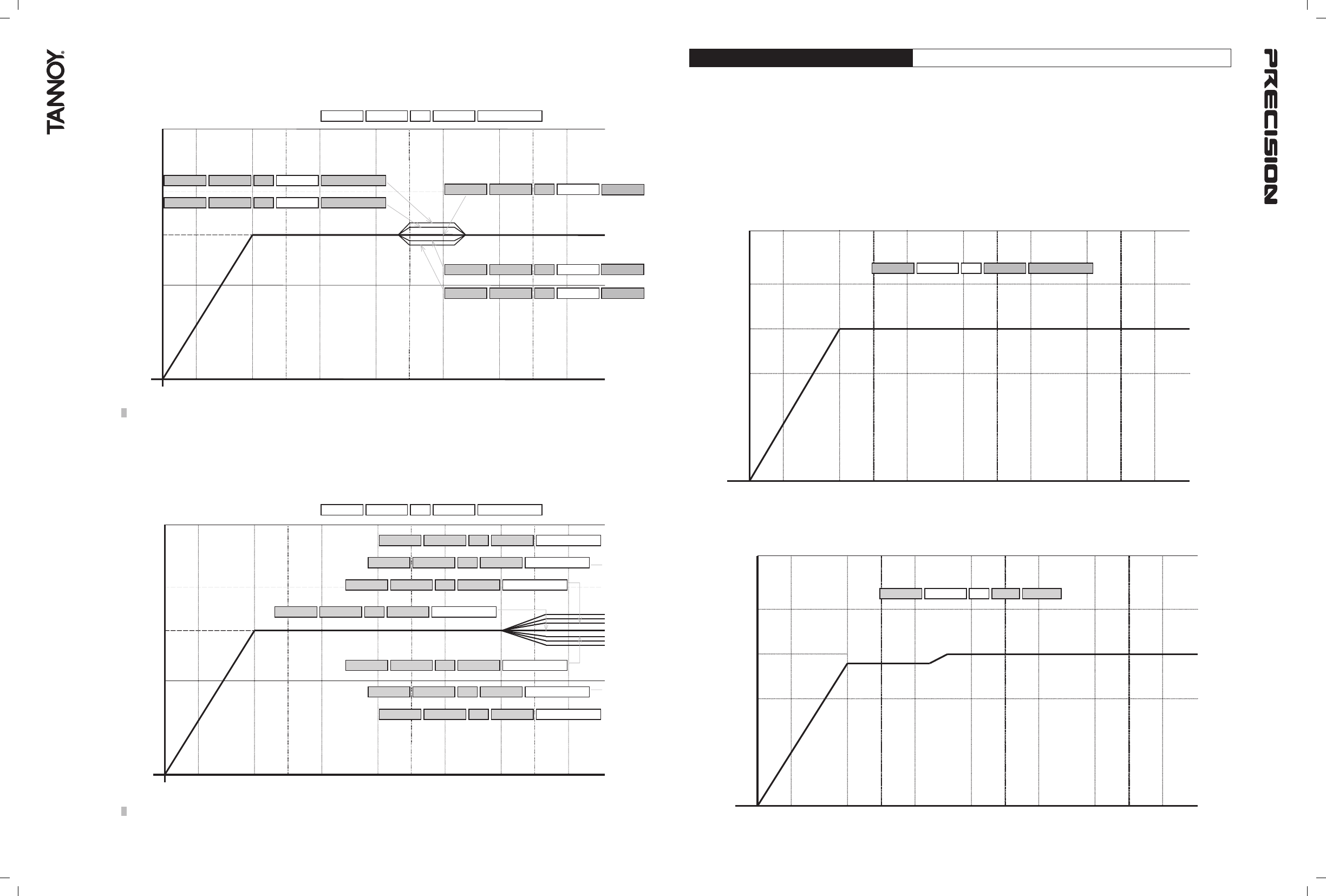
10 11
Hi-Mid Shelf Boost/Cut: a shelving filter between 1kHz and 3KHz can be set to +2, +1dB, flat, -1dB, -2dB, to take account
of room characteristics and personal preference. Editing news broadcast material is often easier with an increased output in
this band. Figure 6 shows the range of adjustment in this area controlled by DIP switches 11 to 14.
High Frequency Shelf Boost/Cut: a shelving filter between 5kHz and 50kHz can be set to +3dB, +2dB; +1dB, flat anechoic,
-1dB, -2dB, -3dB to take account of RT60 decay times for the environment within this band and to allow a degree of personal
preference. Figure 7 shows the range available diagramatically.
10Hz 100Hz 1Khz 10kHz500Hz 5kHz200Hz 2kHz 20kHz20Hz 50Hz
1 1 1 0 1 1 1 0 0 0 0 0 1 1
1 1 1 0 1 1 1 0 0 0 1 1 0 0 0 0 0 0 0 0
1 1 1 0 1 1 1 0 0 0 0 1 0 0 0 0 0 0 0 0
1 1 1 0 1 1 1 0 0 0 0 0 1 0
1 1 1 0 1 1 1 0 0 0 0 0 0 0
LF EQ Low Mids Hz Up Mid Highs
Diagramatic View of EQ Dip Switches: Upper Midband Filter Settings
20 way DIP Switch Bank (4+4+2+4+6)
-10dB
+10dB
0dB re 2.8v
@ 1 metre
Fig. 6. Range of EQ available for DIP switches 11 to 14. All other DIPs set to 'Flat'.
10Hz 100Hz 1Khz 10kHz500Hz 5kHz200Hz 2kHz 20kHz20Hz 50Hz
1 1 1 0 1 1 1 0 0 0 0 0 0 0 0 0 0 1 1 0
1 1 1 0 1 1 1 0 0 0 0 0 0 0 1 1 1 0 0 0
1 1 1 0 1 1 1 0 0 0 0 0 0 0 0 1 1 0 0 0
1 1 1 0 1 1 1 0 0 0 0 0 0 0 0 0 0 1 0 0
1 1 1 0 1 1 1 0 0 0 0 0 0 0 0 0 1 0 0 0
1 1 1 0 1 1 1 0 0 0 0 0 1 0 0 0 0 0 0 0
1 1 1 0 1 1 1 0 0 0 0 0 0 0 0 0 0 1 1 1
LF EQ Low Mids Hz Up Mid Highs
Diagramatic View of EQ Dip Switches: High Frequency Filter Settings
20 way DIP Switch Bank (4+4+2+4+6)
Fig. 7. The range of upper HF EQ controlled by DIP switches 15 to 20. All other DIPs set to 'Flat'
-10dB
+10dB
0dB re 2.8v
@ 1 metre
5.0: A GUIDE TO SETTING THE EQUALISATION
Assess the monitoring conditions and consider these 4 main factors:
1. The environment: free space (4pi), half space (2pi), quarter space (pi) and in the extreme, a "Difficult Space" (pi/2)
2. The distance from the speakers: far field (2 to 3m), mid field (1 to 2m), near field (0.5 to1m) or close field (less than 0.5m)
3. The room: absorbent or reflective surfaces, estimate the RT 60 decay time above 1kHz
4. The nature of the source material: prolonged sessions working on editing bright or forward material can produce fatigue.
10Hz 100Hz 1Khz 10kHz500Hz 5kHz200Hz 2kHz 20kHz20Hz 50Hz
-10dB
+10dB
0dB re 2.8v
@ 1 metre
1 1 1 0 1 1 1 0 0 0 0 0 0 0 0 0 0 0 0
Free Space (4Pi): An example of free space conditions would be with the speakers mounted on tall (0.5m to 1.2m) speaker
stands well away from the wall at one end of a room and with the listener 2 to 3 meters away. Under these conditions set all
the DIP switches to the 'flat anechoic' position. This then provides a high quality high fidelity installation operating in good
acoustically treated environments.
Half Space (2Pi): An example of half space would be with speakers against a wall mounted on stands as above, or on the
meter bridge with the console in the centre of a room. Follow the DIP settings in the diagram below for half space (Pi/2) and
adjust for the listening distance accordingly. Adjust the LF-Q settings to balance the system.
10Hz 100Hz 1Khz 10kHz500Hz 5kHz200Hz 2kHz 20kHz20Hz 50Hz
1 1 1 0 0 1 1 0 0 0
0 0 0 0
0 0 0 0 0 0
-10dB
+10dB
0dB re 2.8v
@ 1 metre
0 0 0 0 0 0
0 0 0 0 0 0
0 0 0 0 0 0












